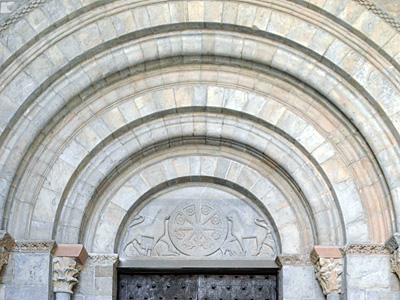The first cathedral of the Iberian Peninsula is in Aragon, specifically in Jaca. Considered one of the most important temples of the first Spanish Romanesque, the cathedral of Jaca is closely linked to the creation of the city, as well as to the history of the Kingdom of Aragon. Its renowned antiquity and its synthesis of its own and other elements make it an essential stop on the Pilgrim’s Route to Santiago de Compostela.
The monarch of Aragon, Sancho Ramírez, endowed the city of Jaca with a charter and it became a diocesan see. And if there is a bishop, there must be a cathedral. Thus it was ordered to build a temple in dedication to San Pedro on the existing monastery of the same name from 1077. Enjoying a privileged enclave, Jaca was the primitive capital of an incipient kingdom between 1077 and 1096, which allowed it to develop as a thriving commercial center on the route of the Camino de Santiago, the one that led pilgrims from Rome to Santiago de Compostela. Another route that passes through Aragon and that you cannot miss is the Marian route, a cultural, religious and natural itinerary.

Romanesque configuration
The cathedral today retains its basic structure and Romanesque configuration: a basilica plan with three naves, divided inside by cylindrical and cruciform pillars, three apses at the head and a large portico with two bays. In the southern apse are located the elements that summarize the characteristic architectural language of the Jaque Romanesque, later spread throughout the Jacobean route: the checkerboard and the balls, which are present in the interior supports.

The visit to the present building, the result of successive reforms, enlargements and destructions, represents a journey through the history and evolution of art, from the first manifestations of the Romanesque to the artistic expressions of the late eighteenth century. All the elements are concentrated in harmonious coexistence as if the cathedral of Jaca were an open book.
Influence on other religious temples
Its symbolic and special style spread throughout the other kingdoms of the Iberian Peninsula, largely thanks to the Camino de Santiago. One of the characteristic elements of the temple is undoubtedly the chesswork of Jaca, based on the alignment of small cylinders with relief that resemble the image of a chessboard. From Jaca its use would extend to other temples such as the Cathedral of Zaragoza, San Martín de Frómista, San Isidoro de León or Santo Tomé de Zamora, among others.
Another of the elements to emphasize of this cathedral is the Crismón of its main door. Located between two lions, it is of great importance both for its architectural validity and for what it represents. In medieval temples, the entrances to churches were more than just a place of passage, as they marked the separation between the earthly world and the House of God. Represented for the first time in Jaca, this ornamental motif would later be extended to all Aragonese churches.

More history: the citadel of Jaca
One of the most grandiose and singular fortresses of the Modern Age in Spain, this construction of pentagonal plant of the XVI century is the only one of its kind that is conserved in all Europe. Back in 1592, Philip II ordered the construction of the fortress as a defense strategy against the invasion of the Tena Valley by troops from the South of France.
Completely surrounded by a moat, it still perfectly preserves all its characteristic parts from the bastions, the powder magazines or the tunnels to its beautiful entrance which is accessed through a drawbridge operated from inside. In a perfect combination of history and fun, the citadel of Jaca houses the Castle of San Pedro and the Museum of Military Miniatures. The latter is a review of the history of the world’s armies from antiquity to the twentieth century, all through 32,000 miniatures.















